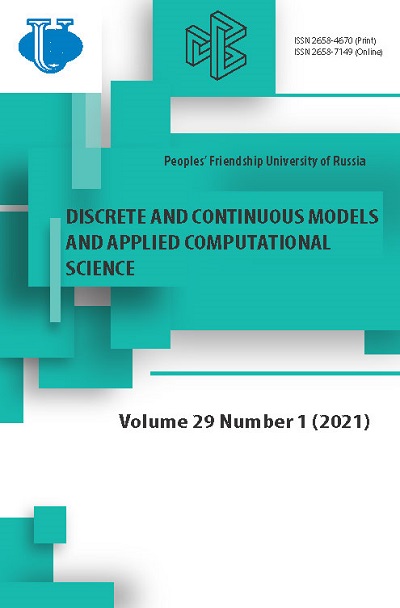On conjugate difference schemes: the midpoint scheme and the trapezoidal scheme
- Authors: Ying Y.1, Malykh M.D.2
-
Affiliations:
- Kaili University
- Peoples’ Friendship University of Russia (RUDN University)
- Issue: Vol 29, No 1 (2021)
- Pages: 63-72
- Section: Articles
- URL: https://journals.rudn.ru/miph/article/view/26141
- DOI: https://doi.org/10.22363/2658-4670-2021-29-1-63-72
- ID: 26141
Cite item
Full Text
Abstract
Full Text
Introduction Dynamical systems are the most important mathematical models in me- chanics and physics. Only a few of these models are integrated in a closed form [1], therefore, they have to be investigated using numerical methods, of which the most important is the finite difference method. Let
About the authors
Yu Ying
Kaili University
Author for correspondence.
Email: 45384377@qq.com
Candidate of Physical and Mathematical Sciences, Assistant Professor of Department of Algebra and Geometry
3, Kaiyuan Road, Kaili, 556011, ChinaMikhail D. Malykh
Peoples’ Friendship University of Russia (RUDN University)
Email: malykhmd@pfur.ru
Doctor of Physical and Mathematical Sciences, Assistant Professor of Department of Applied Probability and Informatics
6, Miklukho-Maklaya St., Moscow, 117198, Russian FederationReferences
- A. Goriely, “Integrability and nonintegrability of dynamical systems,” in Advanced Series in Nonlinear Dynamics. Singapore; River Edge, NJ: World Scientific, 2001, vol. 19. doi: 10.1142/3846.
- D. Greenspan, “Completely conservative, covariant numerical methodology,” Computers & Mathematics with Applications, vol. 29, no. 4, pp. 37-43, 1995. doi: 10.1016/0898-1221(94)00236-E.
- D. Greenspan, “Completely conservative, covariant numerical solution of systems of ordinary differential equations with applications,” Rendiconti del Seminario Matematico e Fisico di Milano, vol. 65, pp. 63-87, 1995. doi: 10.1007/BF02925253.
- J. C. Simo and M. A. González, “Assessment of Energy-momentum and Symplectic Schemes for Stiff Dynamical Systems,” in American Society of Mechanical Engineers. ASME Winter Annual Meeting, New Orleans, Louisiana, 1993.
- E. Graham, G. Jelenić, and M. A. Crisfield, “A note on the equivalence of two recent time-integration schemes for N-body problems,” Communications in Numerical Methods in Engineering, vol. 18, pp. 615-620, 2002. doi: 10.1002/cnm.520.
- G. J. Cooper, “Stability of Runge-Kutta methods for trajectory problems,” IMA Journal of Numerical Analysis, vol. 7, pp. 1-13, 1 1987. doi: 10.1093/imanum/7.1.1.
- Y. B. Suris, “Hamiltonian methods of Runge-Kutta type and their variational interpretation [Gamil’tonovy metody tipa Runge-Kutty i ikh variatsionnaya traktovka],” Matematicheskoe modelirovaniye, vol. 2, no. 4, pp. 78-87, 1990, in Russian.
- J. M. Sanz-Serna, “Symplectic Runge-Kutta schemes for adjoint equations, automatic differentiation, optimal control, and more,” SIAM review, vol. 58, pp. 3-33, 2016. doi: 10.1137/151002769.
- E. Hairer, G. Wanner, and C. Lubich, Geometric numerical integration. Structure-preserving algorithms for ordinary differential equations. Berlin Heidelberg New York: Springer, 2000.
- V. P. Gerdt, M. D. Malykh, L. A. Sevastianov, and Yu Ying, “On the properties of numerical solutions of dynamical systems obtained using the midpoint method,” Discrete & Continuous Models & Applied Computational Science, vol. 27, no. 3, pp. 242-262, 2019. DOI: 10.22363/ 2658-4670-2019-27-3-242-262.
- Y. A. Blinkov and V. P. Gerdt, “On computer algebra aided numerical solution of ODE by finite difference method,” in International Conference Polynomial Computer Algebra’2019; St. Petersburg, April 15-20, 2019, N. N. Vassiliev, Ed., SPb: VVM Publishing, 2019, pp. 29-31.
- F. Klein, Vorlesungen über Nicht-Euklidische Geometrie. Springer, 1967. doi: 10.1007/978-3-642-95026-1.
- P. F. Byrd and M. D. Friedman, Handbook of Elliptic Integrals for Engineers and Scientists. Springer, 1971. doi: 10.1007/978-3-642- 65138-0.
Supplementary files















